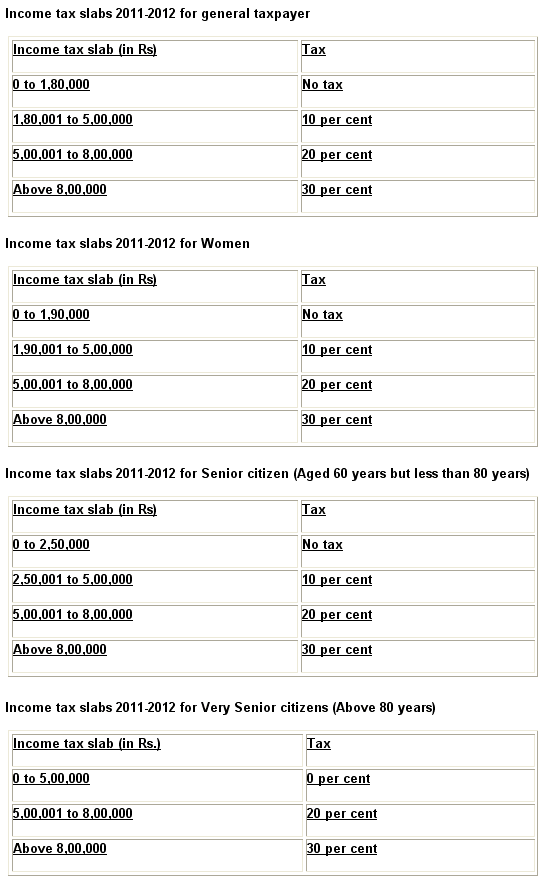Photographs: Rediff Archives Investment-mantra.in
It has been observed that most investors who do tax saving near closing of the financial year end up buying policies which don't match their financial objectives and are also an easy prey to agents selling bad financial products.
Before we go in details of how you can save more tax, let's go through some of changes introduced in this year's budget and various tax slabs.
Base slab for general taxpayers increased to Rs 1.8 lakh from Rs 1.6 lakh.
Senior citizens' age was reduced to 60 years from last year's 65 years. Senior citizen now includes people between 60 and 80 years.
Also the base slab for senior citizen has been increased to Rs 2.5 lakh from RS 2.4 lakh.
A new category called 'Very Senior citizens' was added for people above 80 years.

Investors who are unaware of how tax-planning works need to extract some time and put in some effort to understand how your tax liability is calculated. In addition they should also be aware of different incentives, allowances and rebates under the Income Tax Act. Apart from the Section 80C deductions, there are various other sections which can help salaried individuals save taxes.
There are no secrets or mantras to save more tax. Just follow the basics to investing in tax saving instruments and more importantly how much one needs to invest.
Courtesy: www.investment-mantra.in
8 SMART ways to lower your tax liability
Here are few pointers to you:
1.Exhaust your entire Section 80c deduction
Under Section 80C, the maximum deduction available is Rs 1,00,000 per annum which investors should seek to utilise. Make sure that financial products you choose are in line with your overall financial planning.
In addition, individuals do make investments of over Rs 1, 00,000 under Section 80C designated avenues but they need to understand that the benefits are capped. For instance, investing Rs 70,000 in Public Provident Fund and Rs 50,000 in ELSS funds will give you tax benefit of Rs 1,00,000 only. In addition make sure that you keep in mind your Employee Provident Fund (EPF) yearly amount too while investing for 80c deduction.
Always look at the investments from the perspective that it should meet your specific requirements on maturity. You should also try to diversify your savings in different instruments.
Following are some of the investments/contributions qualify for Section 80C deductions:
Equity Linked Savings Scheme (ELSS): This product can help people in all tax brackets to save taxes while giving inflation-adjusted returns. The investor does not need to pay any tax on withdrawal too. ELSS has a lock-in period of three years, the shortest among all tax-saving instruments.
Unit-linked insurance plans (ULIPs): These products too can provide inflation adjusted returns and opportunity to create wealth in the long term, as they invest in equities and debt papers. However, you need to keep investing regularly and wait until the maturity, as high upfront charges eat into returns of the older products (issued before September 1, 2010). Even after the recent regulatory changes in ULIPs, they are still expensive investment vehicle compared to mutual funds.
Other insurance plans: Covering risk is essential for your goals. Buy insurance for actual requirement rather than for saving taxes. That's why opt for a term plan, as oppose to endowment and money back, as the former offers highest risk cover for low premiums. The premiums paid are eligible for deduction under Section 80C.
New Pension Scheme (NPS): This is the most recent entrant to the Section 80C instruments. It can be a good option for retirement planning with tax savings. The drawback is that the amount is taxable on withdrawal on maturity.
Pension plans: Contribution to pension plan is allowed as deduction under Section 80CCC. Pension plans can be traditional or unit-linked, or from mutual fund houses.
Other products that are covered under Section 80C are National Savings Certificate, senior citizen savings scheme, five-year fixed deposits, including accrued interest, tuition fee for two children for full time courses, home loan principal repayment. The combined limit of deductions under Section 80C, 80CCC and 80CCD is Rs 1 lakh.8 SMART ways to lower your tax liability
2. Long term Infrastructure bonds
Government of India has allowed certain Infrastructure companies to issue long-term tax-saving infrastructure bonds. Investors of these infra bonds can claim tax exemption under section 80 CCF of the Income Tax Act, 1961 for an amount up to Rs 20,000. This deduction is in addition to Rs 1, 00,000 limit available under sections 80C, 80CCC and 80CCD read with section 80CCE.
Should you invest?
It makes sense for people in the over Rs 8 lakh taxable income slab to use the infrastructure bonds as a tax-saving instrument.
For the people in the Rs 5 to Rs 8 lakh bracket, it would be advisable to invest in infrastructure bonds if the period of investment is three years, but not for five years and for those in the Rs 1.6 to Rs 5 lakh bracket, it would be an absolute no-no to invest in infrastructure bonds for tax-saving purpose.8 SMART ways to lower your tax liability
Everyone who is receiving the HRA benefits from their employer is eligible to declare the HRA as the tax savings. Note that, if you are staying in the rental house then only it is applicable. If you reside in your own house, then you will not be eligible to claim the tax benefits for HRA paid by your employer.
The details about the HRA exemption is described under Section 10 (13A) of the Income Tax act 1961. The following are the three conditions to eligible for HRA exemption:
- HRA must be included in your salary component
- You are staying in the rented house
- Your rent is more than 10 per cent of your salary
8 SMART ways to lower your tax liability
4. Opt for joint home loan
If you are planning to buy a house, opting for joint home loan can be a better option. The principal repayment on a home loan is eligible for a deduction of up to Rs 1,00,000 per annum and the interest paid is eligible for a deduction of up to Rs 1,50,000 per year.
In cases where the home loan is for a substantial sum, it is not uncommon for the interest and principal repayment to exceed the stated limit. To ensure that the tax benefit is optimally utilised, an individual can consider opting for a joint loan with his spouse or parent or sibling.
This will ensure that both the co-owners can claim tax deductions in the proportion of their holding in the loan. The co-owner falling in the higher tax bracket should hold a higher proportion of home loan to ensure that the tax benefits are maximised.8 SMART ways to lower your tax liability
5. Other deductions for salaried taxpayers
If your employer provides medical allowance, you can available an income tax deduction of up to Rs 15,000 per year by offering proof of the relevant expenses.
If the employer gives leave travel allowance as a part of your salary, you can avail income tax deduction on travel expenses (family travel expenses can also be covered if family travels along with the taxpayer).
Leave travel allowance can be availed twice in a block of four calendar years. Presently, the block applicable is from 2010 to 2013. Leave travel allowance can only be availed on the expenses incurred on domestic travel. However, the travel mode can be anything (taxi, bus, train or air).
Donations
Subject to the stated limits, donations to specified funds/institutions are eligible for tax benefits under Section 80G.
Salaried individuals who plan to pursue higher education should avail of an education loan as the entire interest is eligible for deduction under Section 80E. The loan can be for self, spouse or child from an approved charitable institution or a notified financial institution.8 SMART ways to lower your tax liability
6. Turn stock losses into tax gains
You can gain from short-term losses you made in stocks according to the Income Tax Act. If you have made long-term capital gains from sale of property, gold or debt funds, you can set them against short-term capital losses made on stocks and bring down the tax liability. Short-term capital losses can be set off against both short-term capital gains as well as taxable long-term capital gains.
Proofs required are records of your equity trading account statements with details of the transactions that resulted in losses.
Let's understand it with help of an example:
Assume you have sold a property and made long-term capital gains of Rs 30 lakh after indexation. At 20 per cent, the tax payable on this long-term capital gain is Rs 6 lakh. However if you have sold some junk stocks during this year and made a short-term loss of Rs 3 lakh, you can set this against gains from the property.
Then the gain from the property will get reduced to Rs 27 lakh and tax payable will be Rs 5.4 lakh.
Long-term capital losses, however, can only be set off against taxable long-term capital gains.8 SMART ways to lower your tax liability
7. Dependent is ill: Pay lower tax
The Income Tax Act allows a taxpayer to claim a deduction of Rs 40,000 if there is a dependent who suffers from ailment specified under Section 80DDB. The deduction is higher at Rs 60,000 if patient is a senior citizen. Dependents can include spouses, children, parents and siblings.
However, there is a condition wherein the patient should be wholly dependent on taxpayer and should not have separately claimed deduction for the disability.
If the amount spent is reimbursed by an employer or an insurance company, there is no deduction. If the taxpayer gets partial reimbursement of the expense, the balanced can be claimed as deduction.8 SMART ways to lower your tax liability
8. Claim benefits on education loan
Rising cost of higher education is forcing people to borrow money to pay fees of their children professional courses. The interest paid on the education loan is fully deductible from the taxable income under Section 80E. If a parent of legal guardian takes the loan, s/he can claim deduction too for the interest paid for up to eight successive years, starting from the year in which the interest is first paid. Proof required here is loan statement from the lender.
For instance, if you take an education loan at 10 per cent interest for 8 years, you can save Rs 1.41 lakh in tax in highest tax bracket. This can bring effective cost of your loan to 7 per cent per annum.
Let's sum up this write-up with some significant points of tax planning:
1. Preferably do your tax planning in the beginning of the financial year and it should be in sync with your overall financial planning.
2. Tax planning should not be done with intent of saving tax only but to meet your overall financial goals.
3. Do exhaust the quota for Section 80C but don't overdo it as tax exemption is up to Rs 1, 00,000 only.
4. Keep all your bill receipts with you systematically so as to submit them as proofs when required. For instance, make sure you have kept boarding passes of flight tickets etc with you if you were to avail LTA.
5. Joint home loan is always preferable to take. So do consider it before availing it.
6. Long term infrastructure bonds benefit the most to people in the over Rs 8 lakh taxable income slab.
7. Do challenge your agent reasoning while zeroing in on some financial products for you. Do read about the product before talking to your agent.
Be a smart investor to minimise your tax liability and attain your long-term goals.









Comment
article